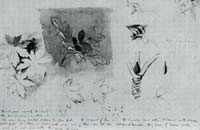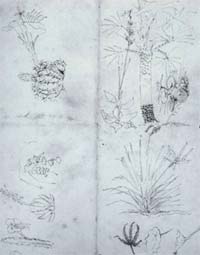
Fig. 1 Ruskin, Studies of leaves. |
Gaudí and
Ruskin
John Ruskin (1819-1900)
was an English critic and social theorist who became a virtual dictator of
artistic opinion in England during the nineteenth century but his reputation
was to decline after his death. It
is highly probable that Ruskin had a major influence
on Gaudí in his political
and social ideals and he was certainly known in Barcelona
and to Gaudí at
the turn of the century.
A leading figure
in the revival of Catalan literature, Manuel Milà i
Fontanals (1818-84), had been in contact with the Pre-Raphaelites, could have
promoted an interest in English aesthetics and it is known that Gaudí attended
his lectures. |

Fig. 2 Plant
sketches by Gaudí ,
(date unknown). |
Also Güell,
very much an Anglophile, would very likely have returned from business trips
in England with news and literature.
It was in 1901 that the first translation of Ruskin appeared in Catalan with
a selection of his writings in a cheap popular edition of L'Avenc . This
was followed by a more extensive anthology in 1903. These
two publications were translated by Cebiá Montoliu who was mainly concerned
with Ruskin's natural history and geological interests,
dividing the larger books into sections dealing with sky, mountains, stones,
water and flowers.
Ruskin
was also introduced to the Spanish public, including Gaudí, as a political
economist. Sesame and Lilies (1865) was
translated into Catalan in 1905 and into Spanish in 1907 and both Unto This
Last (1862) and Munerva Pulveris (1872) were available by this time . These
works attacked bourgeois England and proclaimed a positive programme for social
reform advocating old-age pensions, nationalisation of education and organisation
of labour. Unto This Last consisted of four essays that are foremost
an outcry against poverty, oppression, the perceived
heartlessness of political economy, post-enlightenment
thinking and the emerging capitalism. The ideals that Ruskin held regarding the
worker's welfare, poverty and the heartlessness of political economic decisions
would have gained sympathy with both Gaudí and
Güell as was reflected in their project The Colònia Güell.
Next >> |